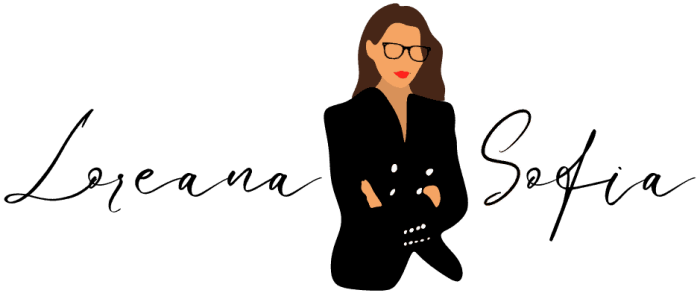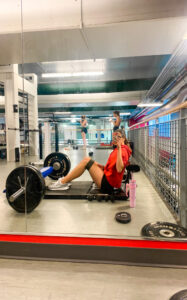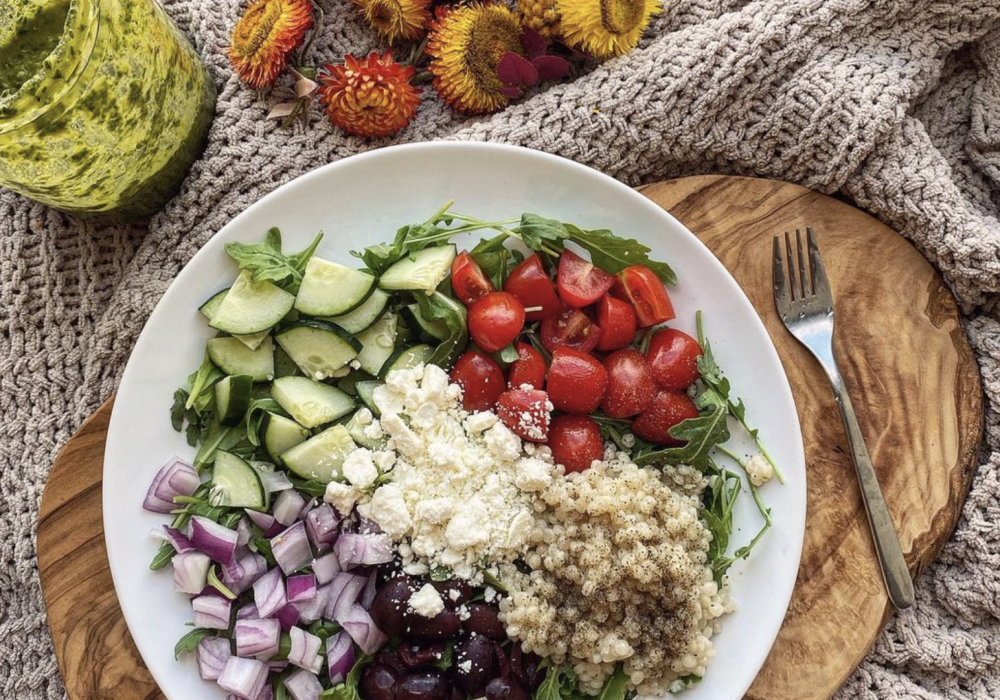These simple healthy tips for everyone will help you avoid making some mistakes that *most* of us have done when starting to work out. Passing on the wisdom, amiright?
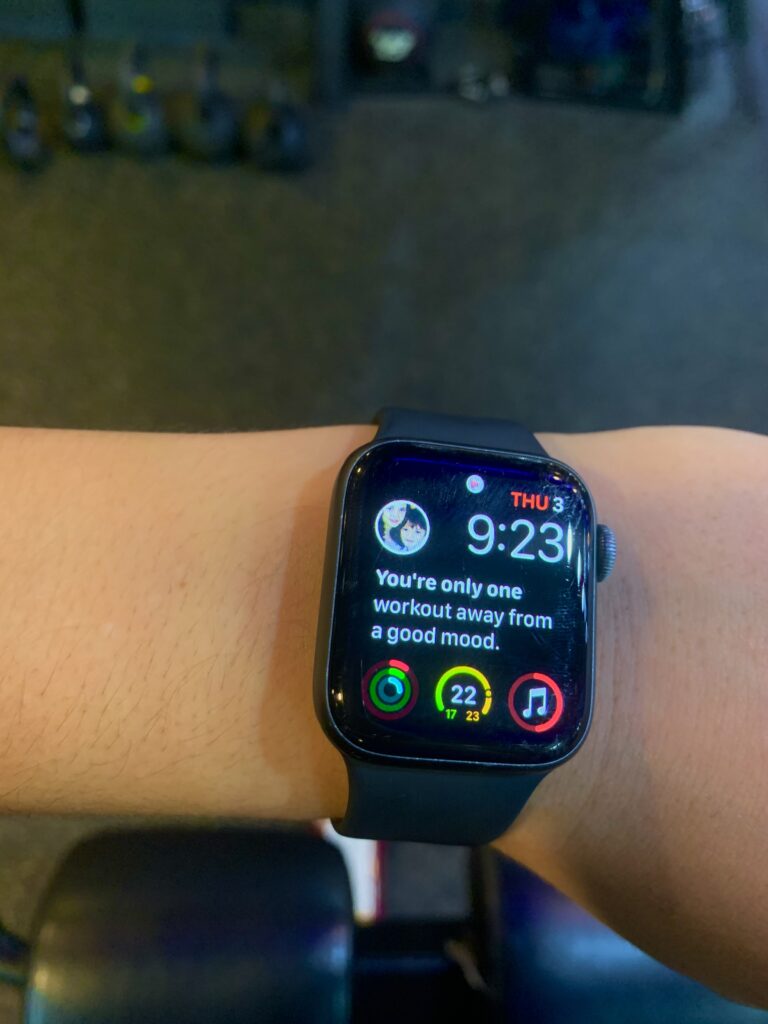
Working out is a learning curve. No matter whether your sport of choice is the gym, a team sport or yoga, it takes practice. Mistakes are to be expected.
And believe me, I’ve done my fair share of mistakes. Those first few months at the gym were not pretty.
Below is a list of all the mistakes that I could have easily avoided when I first started. They will help you get a jump start on things and give you solid guidance when starting.
Now I’m not saying you won’t make any mistakes after reading this. There are some that you just have to go through. But what I’m saying is that these simple healthy tips are straightforward enough for everyone to be able to consider.
This post is all about the 21 simple healthy tips for everyone who just started working out! There is no specific order of importance…
21 SIMPLE HEALTHY TIPS FOR EVERYONE
1. Your pre-workout snack is important
Food is fuel. However, different types of food provide different types of fuel.
In the case of pre-workout, we are looking at how quickly our body can digest different foods. Fats are the foods that take the longest to digest, followed by proteins and carbs.
So when it comes to a workout, you want to eat something as close as possible to the activity to get that energy. However, you want it far enough so you aren’t digesting it as your workout. Basically, you want the blood and energy in your body going to your muscles, not your digestive system.
So, that’s why you want to be eating CARBS about 30 minutes before your workout. Any form of processed carbs is the quickest to digest. Personally, my favourite pre-workout are… Poptarts. Yes, you read that correctly.
Studies have shown that eating protein can also be very beneficial as a pre-workout snack. Basically, since protein takes longer to digest, then the energy will be “released” throughout the length of your workout instead of only having it at the beginning. This is an overly simplified way of explaining it but it gets the point across.
You want to avoid fats altogether since they take much longer to process.
In any case, you want to test out how long before a pre-workout snack is optimal for your body and what is best. I like to keep my pre-workout snacks the same day-to-day so I really have time to figure it out.
2. Pre-workout drinks will only work for so long
Pre-workout drinks are often made from caffeine (like 99% of the time).
Whether you’re buying energy drinks like Monster or Red Bull, or whether you buy pre-workout powder, the secret ingredient is caffeine. The goal of this is to increase blood flow so that your performance improved while you work out.
Like all drugs, caffeine will have a decreasing effect over time. In other words, there will come a point when you will have to take more and more quantities of caffeine in order to get that same increase in blood flow and performance. This just means your body will get used to the amount of caffeine. (I believe this might be a simple healthy tip that many gym goers overlook)
NOT taking caffeine will make you feel really “low” because your body has gotten used to getting it. In rough terms. You’re basically putting your body in withdrawals. You’d have to take a pre-workout just to feel the “normal” from before starting to take it.
So moral of the story is to use caffeine and pre-workout wisely. Taking a few times a month will give you the effect you are looking for.
MyProtein has a really great Non-Stim pre-workout: aka, no caffeine is used. Instead, the main ingredients are VASO6, an ingredient derived from green tea extract, and Citrulline, an amino acid. (I am not getting paid anything for this recommendation btw 
This is a safer and less addictive form of pre-workout which I highly encourage. (But even this I discourage from every single workout.) KEEP IN MIND THAT A PRE-WORKOUT DRINK SHOULD NOT REPLACE A PRE-WORKOUT SNACK.
3. Your workout isn't wasted if you don't eat proteins immediately after
There is a really whacked belief that if you don’t take a protein shake IMMEDIATELY after your workout, you lose the benefits of that workout.
Lie, lie, lie, lie, lie.
If we go to the research, then yes: drinking a protein shake after a workout will boost the benefits. But people fail to also report the numbers: the benefits are MINIMAL, basically NEGLIGIBLE. It barely makes any difference at all.
This research makes sense if you just came out of running a marathon or doing any other form of extremely long exercise. But at this point, it’s also valid for carbs and fats as well.
Just do your workout, and eat well throughout your day. The only workout that is wasted is the one you didn’t go to.
4. Working out on an empty stomach won't boost results
Another myth. Another fake simple healthy tip for everyone to understand. You don’t burn more fat working out on an empty stomach. (Okay, technically, technically, yes. But so much science goes into this that at the end of the day, it doesn’t make a difference.)
What counts is how many calories you are eating in total. Are you in a calorie deficit or calorie surplus?
Working out on an empty stomach will not make you lose fat if you end up eating more calories throughout your day than you are burning.
And if you do lose weight, it’s simply because you ARE in a calorie deficit- not because you’re working out on an empty stomach.
If you are someone who prefers to work out on an empty stomach, then by all means go ahead. But don’t do it if you think it helps you lose fat.
5. You. Cannot. Spot. Reduce. Fat.
Please do not be fooled by those “killer ab workouts” or “ballerina leg routines” that are publicized everywhere.
You cannot dictate where in your body you lose fat first. That is something that your body alone chooses.
Focus on being in a calorie deficit, focus on working out and doing compound lifts. Focus on strengthening your muscles and let your body deal with your fat.
Some people lose fat in the face first, others in the stomach, others in the thighs, others in the arms, and others in their right pinky toe. It is not up to you.
Nutrition Coaching
Train hard. Eat well. Build your body one day at a time.
Train hard. Eat well.
Build your body one day at a time.
1-to-1 coaching. A sustainable nutrition plan. A lifetime of knowledge.
6. Act on the difference between needing a break and being lazy
This will become really important.
I can guarantee you that the progress that you’ve seen others achieve at the gym did not only rely on motivation, it relied on discipline.
So it is crucial for you to understand your body’s difference between needing a break and being lazy.
If your body needs a break, then take it. Does it feel really run-down? Are your muscles really sore? You’ll start to notice the differences as you go more often.
If you’re just being lazy, you’ll know it too. This is when the discipline kicks in and you bring your ass to the gym anyways. There have been SO MANY times when I have gone to the gym when I REALLY didn’t feel like going, but that consistency will beat anything.
In anything in life, consistency is King. If you put this into practice, this might be the simple healthy tip that might help you most in your entire life. Mention me when acception your Grammy Award or Pulitzer Prize.
7. Warm up correctly
Contrary to what many people believe, running is not a good warm-up.
I mean, it is if the workout you’ll do after is cardio-intensive. But not if it’s a conventional weight-lifting workout.
Think about a warm-up as a period where your brain starts firing signals to certain parts of your body saying “okay guys, it’s time to wake up. We’ll be doing [fill in the blank] soon.”
You want that [fill in the blank] to be accurate. If you start a workout by running a few miles on the treadmill, what signals do you think your brain is sending? Right: that you’ll be doing some sort of cardio-intensive workouts.
But those signals are no use if you’ll be doing, for example, low-reps and heavy-weight squats. In this case, you want to warm up the right joints (knees, hips, ankle) and muscles (glutes, quads). And you want to do so with weights as well.
Warm-ups are like baby steps leading to the big thing. Running is not a baby step to squats. Deep goblet squat activation is a baby step.
Running is not a baby step to bench press. Face pulls are a baby step.
Running is a great baby step to, for example, a HIIT workout.
If you want more details, I’ve talked about this more extensively in this article about red flags to look out for in a personal trainer.
8. Workout all body parts.
Men: workout your legs. This simple healthy tip for everyone of you to take at heart: you need to workout your legs.
Women: workout your upper body. It will not make you boxy, it will not make you look like a man.
A part of working out is to be best trained for everyday needs. Transporting boxes when moving, picking up your kids, opening that jar of pickles.
Go a whole day without using the body part you refuse to train: that should be encouragement enough that you do indeed need to train it.
9. Plan out your workouts so you know that you're hitting everything
A well-rounded workout is important.
And a planned workout allows for much better results. In other words, just arriving at the gym and spontaneously deciding what you’ll do isn’t the way to do things – especially if you’re new.
Take the time to plan out your workouts monthly and daily so that you know you’re hitting all the body parts at a good frequency.
When you’ve been going to the gym more often, you’ll be able to sometimes go without a plan… but that’s an art learnt through time. In the beginning, it’s best to go prepared.
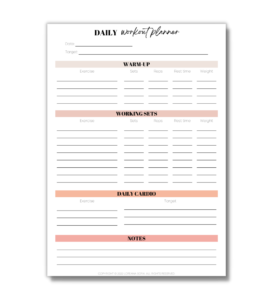
Want a free
DAILY WORKOUT PLANNER?
Watch how your performance, physique and goals improve just by the simple task of using a Workout Planner. Fill out the form below and have the Workout Planner delivered straight to your inbox!
10. Don't blast yourself on your first day
This one is hard to explain, especially if you’re new to the gym. I know that it took me a while to understand.
There’s a difference to make between muscle soreness from pushing yourself in a movement that you’ve been practicing and muscle PAIN. The former is good, the latter… not so much.
The first one feels “good”. It just feels like exhaustion from a long run or something. You still have all the range of motion (i.e. flexibility) that you normally have, and you can still do everything you normally do throughout your day without pain. But going up the stairs feels like you’re doing super heavy step-ups. It lasts one day, maybe two, but then it’s gone.
But PAIN feels like you can’t do what you normally do throughout your day. It’s restrictive. If you really pushed yourself too much, it hurts to even walk normally, and it lasts many days. You don’t want this.
This second pain happens normally when you’re new to weightlifting. You push yourself to the max the first day, but then you aren’t able to do anything for the next week.
I know that it’s SUPER tempting to do this. But at least for the first week, just focus on the movement. If you need to add weight, make it minimal. Give your body one week to get used to the new activity you’re doing, and then start slowly stacking up the weight.
After all, there’s nothing more frustrating than getting the motivation to go to the gym, and then being way too sore to go back to the gym for the next 10 days.
11. Do not be scared of going heavy
Once you get past that initial getting-used-to-the-gym as described above… don’t be scared of going heavy.
I don’t think this is a problem among men as much as it is among women.
Lifting heavy weights will not make you look manly. You won’t get massive body-building arms or huge tree-trunk legs. Another simple healthy tip aimed at debunking a myth that you might have thought true.
It takes people YEARS and YEARS to achieve that, days on days of training, and consistency. What makes you think that after a few lifts, you’ll get there?
And anyways, women just don’t have the physique to achieve that nearly as well or as quickly as men can.
And if that isn’t convincing enough, let me say this: let’s say that by some miracle of the world, you do become super boxy and manly looking (which you won’t)… well by that time, you’ll have had enough experience at the gym to know how to reverse it (which you won’t need to).
And anyways, looking boxy and manly has 90% to do with how you eat and only 10% with your actual workouts. And again, it takes YEARS of consistently eating in a certain way that gets you that manly physique.
Below are a few Instagram accounts of women that lift heavy and I KNOW aren’t just fitness influencers who haven’t stepped foot in a gym once in their life. Keep in mind that these women have been going to the gym for 6+ years:
12. Range of motion and form over weights
Let me be the billionth gym rat to tell you this: do. not. ego. lift.
What is ego lifting? It’s lifting as much as you possibly can disregarding your form.
One of the reasons I love the gym is that people tend to underestimate how much PRACTICE it takes to perfect a movement. Even people who have been going to the gym for years are still aiming to perfect a movement. And sometimes, that includes lifting far less than they’re physically capable of to only work on the movement.
So please, focus on your form and your range of motion. I promise you that you will get way better results (and more compliments) from a movement that is better executed with less weights than a poorly executed movement with a butt-load of weights.
13. Keep track of your PRs
PRs are personal records, aka what is the heaviest or most volume you’ve lifted.
Say that the best you’ve lifted is 1x100kg in a deadlift, then your PR is 100kg for 1 rep. That’s your heaviest.
However, say that for hip thrusts, you reached 5 reps of 150kg. Then your PR is 150kg for 5 reps, and your volume PR is 750kgs (5×150).
Aside from being a good motivator, keeping track of your PR can help you tell if you need to change things up. If you haven’t lifted a new PR in a long time, or if you see that you aren’t able to lift the PR weight you once did, then it might be a sign that you’ve hit a plateau and it’s time to change things up.
And anyway, keeping track of your PRs is nice to look back on.
14. Adapt your workout to what you do in your day-to-day
Do you practice any other sports? Does your day-to-day job involve carrying heavy objects? Whatever it is that you do on a daily basis, make sure to strengthen it at the gym.
For example, I horseback ride. And a big part of riding is engaging your hip flexors, as well as all your adductor muscles (interior leg muscles). The stronger those are, the better you ride. So, when at the gym, I make sure to always include the adductor machine, or banded leg raises.
This logic is applicable to any movement that you do often.
15. Rest days are good and needed
I will be the first one to admit that when I first started going to the gym, I used to feel HELLA guilty for taking rest days.
You do not need to put yourself through the same guilt trip as most of us do when we start.
Rest days are needed. Your body needs time to recover and heal from the probable BEATING you put it through at the gym.
And especially if you go through major hormonal changes what with getting your period, this is even more emphasized.
Listen to your body.
16. The calories you burn during your workout are irrelevant
I’ve referred to this point more extensively in my post on 9 Nutrition Facts That Will Make Sustainable Weight Loss So Much Easier.
But basically, you burn X amount of calories per day. Most of those calories are burnt through your metabolic functions (digestion, breathing, etc). Only about 5% of those calories are actually burned through exercise. The chart below shows exactly how your calories are burnt throughout the day.
So basically, this means that if you’re to lose weight, do not rely on just your 1-hour workout session.

17. Calories in vs Calories out
The only thing you need to understand about fat loss or mass gain is calories in versus calories out.
If you are trying to lose fat, then you need to be in a calorie deficit. This means that you need to be burning off more calories during the day than you are eating. A 200-400 calorie deficit will do just fine.
Very basically, when you eat less than you burn, your body has to go tap into stored energy reserves, aka your fat. By using this energy, it burns off fat!
On the other hand, if you are trying to build muscle, you need to be eating more than you burn.
So basically, your body cannot create new tissue out of thin air. It needs to be given those building blocks, which in this case are in the form of protein. So you basically need to be eating slightly more than you burn, focusing on protein, in order to build muscle.
18. Proteins will help you a lot : focus on getting enough
Whether you’re trying to lose fat or gain muscle, proteins are extremely important. Basically, this is one of those simple healthy tips for everyone to adopt now.
For fat loss, proteins will keep you fuller for longer so that remaining in a calorie deficit will be easier.
If you are trying to gain muscle, proteins are like your little construction men. Proteins are composed of amino acids, and amino acids are the building blocks of protein.
So in any case, focusing on protein-rich foods will help you a lot. And in both cases, your body and muscles need proteins for more than just fat loss or muscle gain.
19. Carbs are not the enemy
Unless you have a medical reason to do so, there is no reason that you should be cutting off carbs.
They do not make you fat. They do not store more fat. They are not higher in calories (in fact, 1g of carbs has 4 calories, the exact same thing as proteins). Carbs are NOT your enemy.
Actually, let me tell you that when it comes to energy levels, carbs are your best friend. In fact, energy is extracted from glucose, which is primarily present in carbs.
If you hear anywhere that you should be cutting out carbs, run.
However, there is a point to be said about processed carbs. Indeed, most processed foods are very high in processed carbs and oils, which pack a lot of calories. As a result, they are less efficient if you are trying to lose weight. So as long as you understand the basic premise that natural forms of carbs (such as veggies, rice, potatoes, etc) are more efficient and “healthier” than processed carbs such as candies, then you’re good to go.
But let me tell you one thing: if your maintenance level is at 2100 calories, you will gain weight whether you eat 2300 calories of pure protein or pure carbs.
20. Water, water, water.
Water will be your BFF no matter what your fitness goal is. And I can almost guarantee you that you are not drinking enough water throughout the day. This simple healthy tip for everyone… really is for everyone.
I think of walking similar to other tips like “increase the antioxidants in your meals”, “eat more veggies” or “spend time in the sun”. It’s one of those simple healthy tips for everyone to adopt that has a positive effect on a myriad of things in your life.
Wanna be in a calorie deficit? Water will keep you fuller.
Wanna recover from a heavy workout, muscle tension and soreness? Water will help drain out those toxins and transport the necessary nutrients.
Want clearer skin? Water keeps that skin hydrated and plump.
Now, if only there was an article about tips on how to drink more water throughout the day…
21. Don't starve yourself.
I love the sentence “life is a balancing act”. Basically, if you deprive yourself of something for too long, life will balance it out by throwing whatever you’ve been avoiding right back at you, 10 times harder.
This exact concept applies to food. If you try to starve yourself in order to lose weight, I can guarantee you that in a couple of days (or hours) you will be eating everything out of your pantry.
It just isn’t sustainable!
And if through some massive willpower, you manage to only eat very few calories for too long, then your body will have adapted to that. In other words, if you only eat (example) 1200 calories for too long – which is nothing – then your body will have adapted to having to thrive on only 1200 calories. The end result is that the moment you start eating above 1200 calories, your body will store those extra calories as fat.
I hope these 21 simple healthy tips got everyone who just started going to the gym have helped you avoid the mistakes that most of us run into when we first started!
xx LS
Share this post
